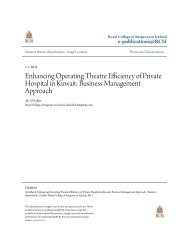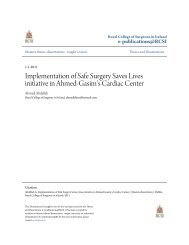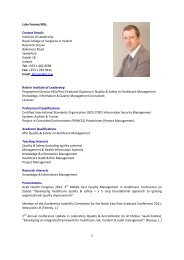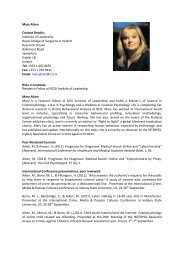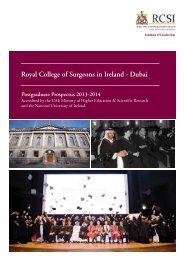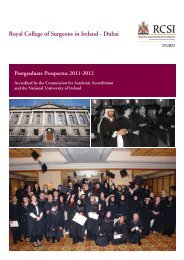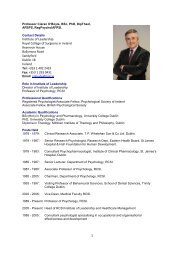Improving the Assessment and Triage of Patients with Mental Illness ...
Improving the Assessment and Triage of Patients with Mental Illness ...
Improving the Assessment and Triage of Patients with Mental Illness ...
Create successful ePaper yourself
Turn your PDF publications into a flip-book with our unique Google optimized e-Paper software.
The benefits <strong>of</strong> successful implementation <strong>of</strong> <strong>the</strong> project were outlined to staff. The<br />
changes were patient focused. All staff were furnished <strong>with</strong> hard copies <strong>of</strong> <strong>the</strong> documents<br />
along <strong>with</strong> <strong>the</strong> project impact statement. They were requested to consider <strong>and</strong> disseminate <strong>the</strong><br />
information which contained <strong>the</strong> rationale <strong>and</strong> <strong>the</strong> desired outcomes <strong>of</strong> <strong>the</strong> change. It was<br />
established that as I was proposing <strong>the</strong> change initiative that I would be <strong>the</strong> change agent. As<br />
<strong>the</strong> change agent it was my duty to develop a climate for change <strong>and</strong> to delegate<br />
responsibility to o<strong>the</strong>rs in an effort to achieve desirable outcomes (Bennett, 2003, McAuliffe<br />
<strong>and</strong> Vaerenbergh, 2006).<br />
A follow-up meeting for <strong>the</strong> second week in January was arranged to discuss <strong>the</strong>ir<br />
thoughts <strong>and</strong> considerations <strong>of</strong> <strong>the</strong> proposal. These meetings were organised as focus group<br />
discussions. Each focus group would consist <strong>of</strong> between six to eight staff. Discussions would<br />
be related solely to <strong>the</strong> change project <strong>and</strong> meetings would last no longer than thirty minutes.<br />
Times <strong>and</strong> dates for <strong>the</strong> meetings were posted on <strong>the</strong> staff notice board. These first meetings<br />
would a generalised discussion on <strong>the</strong> proposed change to get feedback. Kitzinger (1995)<br />
suggests that focus group discussions help to articulate individual views, generate questions<br />
<strong>and</strong> pursue priorities.<br />
Prior to <strong>the</strong> next meeting staff were requested that while deliberating on <strong>the</strong> proposal<br />
that <strong>the</strong>y would take into account aspects such as, patient safety, <strong>the</strong> impact <strong>of</strong> <strong>the</strong> change on<br />
<strong>the</strong> department, <strong>the</strong> change process being utilised to implement <strong>the</strong> change, <strong>the</strong> affects<br />
positive <strong>and</strong> negative <strong>the</strong> change would have on service users, resources available for <strong>the</strong><br />
change, was it manageable/achievable in <strong>the</strong>ir opinion <strong>and</strong> finally were <strong>the</strong>re aspects that<br />
were deemed acceptable or o<strong>the</strong>rwise. Obtaining buy in from clinical nurse managers was a<br />
crucial aspect as <strong>the</strong>y would be required to encourage <strong>and</strong> keep staff motivated whilst<br />
supporting <strong>the</strong>m <strong>with</strong> <strong>the</strong> change initiative. Welford (2006) suggests that willingness <strong>and</strong><br />
commitment from management is paramount in creating <strong>the</strong> momentum for change among<br />
subordinates.<br />
In preparation for <strong>the</strong> planning phase <strong>of</strong> <strong>the</strong> model, I had to establish how prepared <strong>the</strong><br />
ED, was for change. Madsen et al (2005) highlight that if employees are to be encouraged to<br />
alter <strong>the</strong> way things are done than <strong>the</strong> onus is on managers to recognise <strong>the</strong> factors that<br />
influence readiness for change. A Power Interest Grid was one tool used to assist in ga<strong>the</strong>ring<br />
<strong>and</strong> analysing information to determine whose interests should be taken into account.<br />
21




